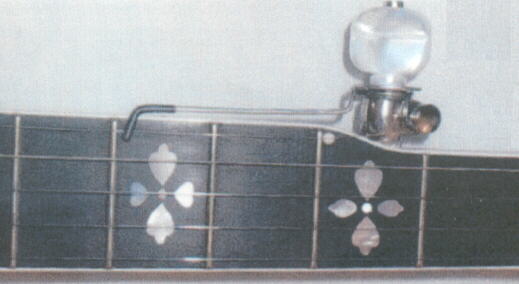|
|
Fifth String Capos
One problem peculiar to the 5 string banjo is that of capoing the fifth string. On a guitar or a tenor banjo or any similar fretted instrument, the capo generally frets all of the strings at the same time, and the relative tuning is maintained when a capo is used. The odd configuration of the 5 string banjo fingerboard, with the fifth string starting several frets up the neck from the rest of the strings makes a second capo for the 5th string a necessity.
One very common solution to the problem is the installation of "neck spikes" in the fingerboard. These are HO gauge model railroad spikes that are placed in the fingerboard in the path of the 5th string, about 1/4 of an inch to 3/8 of an inch behind the frets. The 5th string is slipped under the spike, which serves to fret the string. A good, experienced luthier can install these for you, or you can find information for installing them yourself on Frank Ford's web site at the section called 5th string spikes. Most bluegrass tunes are played in G, A, B, C or D, so spikes at the 7th, 9th, 10th and 12th frets will generally do the job for you. Spikes are cheap and you cannot drop them on the floor or lose them once they are installed on the banjo.
Some people like the Shubb 5th string capo, or any of the capos that were designed by Walt Pittman, such as the Vega capo. They work nicely, but they do mar the neck of the instrument and they get in the way of the left thumb. There is a neat little capo called the "Regan" capo, that attaches to the 5th string by means of a nylon screw. It doesn't harm the banjo but is very easy to lose.
The Riddlefit Fifth String Capo
Recently, I saw a new 5th string capo mentioned on the Janet Davis Music web site. It is called the Riddlefit Fifth String Capo. It works very well. It is easy to install, reasonably priced and will not mar your banjo, unless you are really careless with it. You can fit it to your banjo in about 5 minutes, more if you have to hunt for a screwdriver or if you are clumsy. You simply remove the knob from your geared 5th string tuning peg, install three washers and put the knob back onto the peg. The capo arms simply wrap around the 5th string tuner and press against the fifth string near the fret. There are only two drawbacks. You must have a Kroll style geared 5th string tuner. These are fairly common these days. And it is made specifically to fit a modern Gibson banjo. This does not mean it won't work on other instruments. You may have to bend the end of the capo arms slightly to fit the scale of your banjo. It comes with four capo arms -- A, B, C and D. The arms are made of 400 series stainless steel wire. They store by means of magnets attached to your banjo brackets. See the picture below for more details. You can get more information about these capos from the Riddlefit Capo web site. Stan, who is the fellow at Tone Technologies, LLC, the maker of these capos will be glad to help you with information on them. You may also reach them by phone at 336-945-0427.

The Riddlefit Fifth String Capo
Go back to IBMA 2001
Go back to Banjo Setup
Go back to My Music
©2006 Bill Palmer. All rights reserved. For permission to republish contact Bill Palmer. The opinions expressed on this page are strictly Bill Palmer's. Mastertone, Stelling and the other brand and model names are the property of the manufacturers and other people who own them. | |